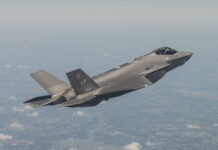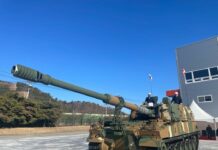Growing Canadian defence industry exports and partnerships are part of healthy and burgeoning industrial landscape for one of NATO’s leading and founding members.
The Canadian defence industry has grown in recent years in a number of areas and the nation’s defence and security technology companies are recognised around the world for their advanced and innovative products and services. Acting as an active business partner to most of those companies, and as their conduit to government, is the Canadian Association of Defence and Security Industries (CADSI). Its members enjoy access to policy insights and expertise, as well as benefiting from CADSI’s longstanding relationship with the Department of National Defence, the Canadian Armed Forces, and market opportunities for them across Canada and with allied nations, created through membership of the Association.
Catching Up
ESD’s Tim Guest spoke with CADSI’s President and CEO, Christyn Cianfarani, about the
Association’s latest views on Canadian defence industry exports and partnerships.
ESD: How big is the Canadian defence industry and does its current size reflect any recent growth, or shrinkage, due to changing operational requirements, or politics?
Cianfarani: The Canadian defence industry contributes to the employment of more than 64,000 Canadians and generates CA$10Bn in annual revenues, roughly 60 per cent of which come from exports. It also contributes over CA$7Bn to the country’s GDP each year. I will note that these statistics are pre-pandemic, dating from 2018. Every two years, CADSI conducts an in-depth survey of the industry in partnership with Innovation, Science and Economic Development Canada and Statistics Canada. The results of the newest survey are expected in May 2022 and will shed some light on how the industry has fared throughout the pandemic.
Anecdotally, we are confident that the industry has grown over the past two years, especially when it comes to our homegrown cyber-defence sector. Canada is currently spending more on defence than it has in several decades, with an additional CA$6Bn over five years announced in our most recent federal budget. We have seen – and will hopefully continue to see – domestic industry rise to meet that demand.
The most recent government-led sector survey, which uses 2018 data, identified 640 defence firms and another 340 firms in cybersecurity. By comparison, CADSI’s membership in 2018 was over 900 firms, which suggested we were able to represent most of the industry, along with many additional firms seeking to do business within the defence arena, like law and accounting firms.
ESD: Please highlight some of Canada’s current leading defence companies and outline some of the most important, regular and sizeable defence-industry exports?
CADSI: Much like when you win an award and have to thank people, listing companies always makes us nervous that we will forget one that provides something outstanding. Canada’s largest defence companies and primes are often – though not always – subsidiaries of American or European firms. What makes them Canadian is the degree to which they hold and generate intellectual property in Canada, export from Canada, and have Canadian-based employees. Notably headquartered in Canada are the shipyards of Irving Shipbuilding and Seaspan, and other firms like MDA, Calian, IMP Aerospace, CAE Inc., and Weatherhaven, to name a few. Some of our larger subsidiaries with significant IP resident in Canada are:
- General Dynamics (more specifically General Dynamics Land Systems)
- Lockheed Martin Canada
- Pratt and Whitney Canada
- Textron
- Rheinmetall
- Thales Canada
From our perspective, the entire sector is important, as it forms an integrated ecosystem that supports the Canadian economy at both a macro and micro level. For example, shipbuilding is a primary driver of Canadian defence work and investment on the east and west coasts, while in Ontario, Canada’s most populous province, there is a complex and active supply chain attached to the production of light armoured vehicles made by General Dynamics Land Systems. But the majority of the Canadian sector is, in fact, comprised of highly innovative, specialised SMEs. They produce world-leading capabilities, not only in traditional defence domains, but also in cyber defence.
Our most export-intensive defence products and services are mission systems/sensors, other electronics, software and related systems, followed by platforms and platform systems. Ground vehicles and components represent CA$1.3Bn of the CA$1.9Bn overall value of military goods exported under permit. Next largest, at CA$140M, is the category that includes aircraft, lighter-than-air vehicles, unmanned airborne vehicles, aero-engines and aircraft equipment, related equipment, and components, specially designed, or modified, for military use.
ESD: On the world stage, how competitive is the Canadian defence industry, how are its products, systems and equipment viewed and received, and what is the current size of Canadian defence exports with financial projections for coming years?
CADSI: Our largest and most important defence trading partner remains the US. Our two defence industrial bases are tightly woven together as we share responsibility for the defence of North America, and we expect to see that relationship deepen further with the modernisation of NORAD. Outside of the US, our industry primarily exports to European countries like the UK and Germany, and these remain very important markets for us. The Middle East is a growing and important region for us, as well.
We often boast that Canada punches above its weight on the international stage, and our capabilities are some of the most sought after in the world. Given that we export more defence and cyber products and services than we buy domestically and that our American allies tend to be our largest export market, it goes without saying that Canada is very competitive on the world stage.
CADSI’s members participate regularly in international defence shows with support from our partners in government, and we welcome dozens of international delegations to our own defence trade show, CANSEC, each spring. While Canada makes few weapons platforms, there are plenty of non-traditional and disruptive defence technologies where Canada has established expertise, like:
- artificial intelligence
- quantum
- robotics
- training and simulation
- cyber
- space capabilities
All that said, the Canadian government rarely practices the kind of high-level defence trade diplomacy common in the UK, France, or the US. Our government does not, as a rule, procure defence materiel in an interventionist or protectionist way, which is why you see so many Canadian companies relying on exports to grow their businesses. The most recent statistical overview of Canada’s defence industry in 2018 shows that the overall export value of our products and services (both permitted and non-permitted) increased from CA$5.5Bn in 2014 to CA$5.7Bn in 2018.
The other source of reliable export data, the Report on the Export of Military Goods for 2020, saw “the value of Canadian exports of controlled military goods and technology amounted to approximately CA$1.966Bn, compared to a value of CA$3.757Bn in 2019.” The report attributes this decrease to the lower value of military exports to Saudi Arabia in 2020, which diminished by CA$1.553Bn compared to 2019.
In terms of projections, we do not have visibility into individual firms’ business plans, making it difficult to project broad trends in Canadian defence exports. However, we expect that exports will continue to play a vital role in our industry’s health and its ability to reinvest and prosper, domestically.
ESD: Are there important domestic defence industry partnerships currently ongoing with prime and sub-contractors working on specific programmes/projects, and can you mention any current, international partnerships between Canadian defence industry players and overseas partners?
CADSI: The most notable example of this kind of [domestic] partnership is Canada’s National Shipbuilding Strategy, or NSS. Launched a decade ago, the NSS represents a complete recapitalisation of the Royal Canadian Navy, with Canadian shipyards currently engaged in the construction of icebreakers, Coast Guard vessels and soon a new fleet of surface combatants based on the UK’s Type 26 frigate. The domestic supply chains attached to these projects are complex, and prime contractors have specific, contractual obligations under Canada’s Industrial and Technological Benefits (ITB) Policy to undertake business activity in Canada equal to the value of the contract. This policy applies to all defence and Coast Guard procurements valued over CA$100M.
We will soon see another example of this type of programme as Canada refreshes its pilot training under the Future Aircrew Training program (FAcT). That project will involve similarly integrated domestic supply and service chains and significant investment into the Canadian economy, including socio-economic investment in indigenous peoples.
As an industry association, we don’t have visibility into specific [international] joint ventures or business partnerships unless the companies involved decide to share that information. Again, a good proportion of Canadian primes are in fact subsidiaries of large international firms. We do know that a lot of the products and services produced by Canadian SMEs, particularly in cyber defence, are destined for international customers.
ESD: What are the prospects for Canadian defence exports looking forward to the end of the decade, and are successes more likely through partnerships?
CADSI: We continue to expect forward-looking growth in Canadian defence exports as we maintain historically high levels of domestic defence spending. In addition, Canada’s highly educated population and investment in research, development, and innovation – including in leading-edge technologies such as artificial intelligence and quantum computing – make us an attractive global partner.
We believe that partnerships are critical to accessing the global marketplace. Not only is defence a tool of foreign policy, but it is also viewed by nations as an economic driver, so by nature, it requires in-country partnerships. When we view that through a national security lens, like in the case of cyber, and we see the threat growing, it is obvious to us that no one country will be able to ‘go it alone’ without allies and without pooling our collective resources.
ESD: Can the Canadian defence industry continue to compete on the global export stage against the leviathans of other western defence industries?
CADSI: Absolutely. We have the technologies, the expertise, and the will to thrive in international markets. But long-term success for our industry and, by extension, the Canadian economy at large will require increased support from the Canadian Government. As mentioned, other countries are far more protectionist and interventionist when it comes to their defence industrial bases, favouring homegrown industry and providing strong supports for firms wishing to grow their presence in international markets. That can mean everything from active trade missions to timely, predictable export-permitting processes.
Canada has a unique relationship with the United States in terms of our collective defence of North America (NORAD) and we remain an active member of NATO. This means that we know what it means to work in partnership with other nations. We understand that in the long-term working collectively, including bringing the best-in-class technology to the table, is the only way in which we will all have enough resources, both financially and in terms of human capital, to defend our values and interests.
ESD: Thank you.
The interview was conducted
by Tim Guest.












